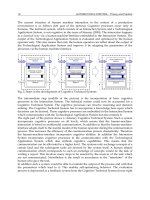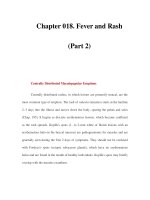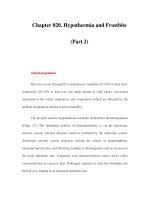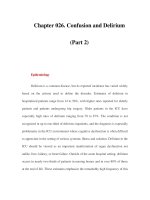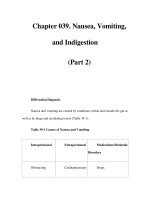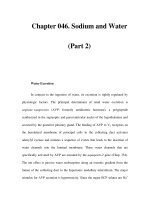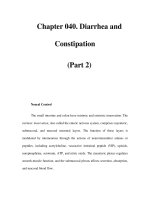The Tourniquet Manual: Principles and Practice - part 2 pot
Bạn đang xem bản rút gọn của tài liệu. Xem và tải ngay bản đầy đủ của tài liệu tại đây (519.61 KB, 12 trang )
century. There were various modifications: according to Chelius, “a pad stuffed with
hair, a strong bandage, an ell and a half or two ells long, a stick of tough wood, and
a piece of leather, which has on both sides a cut for the passage of the bandage”,
allowed more precise pressure on the main artery of the limb.
4
1.1 Screw Tourniquet
Jean Louis Petit, the foremost surgeon in Paris during the first half of the eighteenth
century, described his invention of the screw tourniquet before the Academie Royal
des Sciences in Paris in 1718. He was the first to use the term “tourniquet”, which
is derived from the French tourner (to turn).
5
His tourniquet was a definite advance
because it did not require an assistant to hold the instrument in place, and it could
be released readily and reapplied instantly. The tourniquet consisted of a strap that
passed around the limb and to which the screw portion was attached. When the
screw was tightened, pressure was brought to bear over the main vessel of the limb
by a curved piece fixed to the screw. The first screws were made of wood, but later
they were made of brass (Figures 1.3 and 1.4). Various modifications of Petit’s
apparatus remained in use until the latter part of the nineteenth century. However,
1111
2
3
4
5
611
7
8
9
1011
11
2
3111
4
5
6
7
8
9
2011
1
1
2
3
4
5
6
7
8
9
3011
1
1
2
3
4
5
6
7
8
9
4011
1
211
4
The Tourniquet Manual ➊➁➂➃➄➅➆
Figure 1.2 Jean Louis Petit. Reproduced by kind permission of the President and Council of the Royal College of Surgeons
of England.
5
➊➁➂➃➄➅➆ Historical Background
Figure 1.3 Petit’s tourniquet. Reproduced with
permission of the Wellcome Library, London, from
Savigny, JH (1798).
A Collection of Engravings. The
Most Modern and Approved Instruments Used in the
Practice of Surgery
. The Letter Press by T. Bensley.
Figure 1.4 Screw tourniquet in place. Reproduced by kind permission of the President and Council of the Royal
College of Surgeons of England from Sir Charles Bell (1821).
Illustrations of the Great Operations of Surgery
. London:
Longman, Hurst, Rees, Orme and Brown.
during the Crimean War, the British army reverted to using the simpler strap-and-
buckle tourniquet.
5
1.2 Listerian Methods
Joseph Lister (Figure 1.5), in the 1860s, was the first surgeon to use the bloodless field
for operations other than amputation, “long before the rest of the world had grasped
the idea of operating bloodlessly”.
6
He described how his attention had first been
directed to this subject when trying to work out a satisfactory method for excision of
the wrist joint in tuberculosis to save the hand from amputation and to overcome the
profuse bleeding associated with the procedure
7
:
And I found that when the hand was raised to the utmost degree and kept so for a
few minutes and then while the elevated position was still maintained, a common
tourniquet was applied to the arm being screwed up as rapidly as possible, so as to
1111
2
3
4
5
611
7
8
9
1011
11
2
3111
4
5
6
7
8
9
2011
1
1
2
3
4
5
6
7
8
9
3011
1
1
2
3
4
5
6
7
8
9
4011
1
211
6
The Tourniquet Manual ➊➁➂➃➄➅➆
Figure 1.5 Lord Lister
arrest all circulation in the limb and at the same time avoid venous turgescence, I had
practically a bloodless field to operate on and thus gained the double advantage of
avoiding haemorrhage and inspecting precisely the part with which I was dealing.
Lister emphasised the importance of elevation of the limb before the tourniquet
was applied. He considered four minutes to be the best time to empty the blood
from the limb. There was thus drainage of all the venous blood and, in addition,
arteriolar constriction. Lister gave experimental evidence to prove this point, based
on observations on his own hand and on the exposed metacarpal artery of a horse.
7
1.3 Esmarch’s Bandage
Credit for the method of winding a strip of tensile material around the limb is usually
given to Johann T. Friederich August von Esmarch (1823–1908; Figure 1.6), Professor
of Surgery at Kiel. Von Esmarch was not the first person to use such a device: he
gave credit to Sartorius (in 1806), Brunninghausen (in 1818) and Sir Charles Bell (in
1821) for having used methods of expressing venous blood from a limb in combi-
nation with a tourniquet.
8
Von Esmarch also acknowledged that Grandesso-Sylvestri
in 1871 had used an elastic bandage to empty a limb of blood before amputation.
The original Esmarch bandage was a rubber tube the thickness of a finger, wound
tightly around the limb to serve as a tourniquet after the blood had been expressed
from it by bandaging (Figure 1.7). The “Esmarch bandage” used today was actually
designed by von Langenbeck, based on equipment used by Esmarch; correctly, it is
termed a “Langenbeck bandage”.
9
Esmarch had been bandaging limbs firmly before
amputation since 1855, in an effort to conserve blood because he had been disturbed
at the amount of blood still present in an amputated limb after it had been severed
from the patient. Subsequently, he adopted the technique for other operations on
the limb.
In The Surgeon’s Handbook on the Treatment of Wounded in War, Esmarch gives full
details of his technique
10
:
Operations on the extremities can be performed without loss of blood if they have
previously been made bloodless in the following manner:
1 After the wounds or ulcers, which be present, have been well covered with some
waterproof material (varnished paper) the limb is firmly bandaged with an elas-
tic roller from the tips of the fingers or toes upwards till it has reached beyond
the site of operation: by this means the blood is completely driven out of the
vessels.
2 Where the bandage ends, an India rubber tube (elastic ligature) is wound with
moderately strong traction several times around the limb, so that no more blood
can pass through the arteries. The ends of he tube are fastened together by a
knot or a hook and chain.
3 The arteries can be compressed in most cases by an elastic bandage, firmly
applied in many circular turns and at the end fastened with a safety pin (van
Langenbeck’s Schnurbinde).
7
➊➁➂➃➄➅➆ Historical Background
1111
2
3
4
5
611
7
8
9
1011
11
2
3111
4
5
6
7
8
9
2011
1
1
2
3
4
5
6
7
8
9
3011
1
1
2
3
4
5
6
7
8
9
4011
1
211
8
The Tourniquet Manual ➊➁➂➃➄➅➆
Figure 1.6 Friederich August
von Esmarch.
Reproduced by kind
permission of the President and
Council of the Royal College of
Surgeons of England.
Figure 1.7 Application of
Esmarch’s bandage with a roller.
9
➊➁➂➃➄➅➆ Historical Background
Figure 1.8 (b) Application of the
tourniquet.
Reproduced by kind
permission of the President and Council
of the Royal College of Surgeons of
England.
Figure 1.8 Esmarch (von Langenbeck) bandage
with a rubber tourniquet. (a) Esmarch’s apparatus
for the bloodless operation.
4 When the elastic bandage is taken off . . . if the circulation has been effectively cut
off the limb exhibits a completely blanched appearance like that of a dead sub-
ject, and any operation can be performed without loss of blood in dead subject.
Parts which contain unhealthy pus must not be firmly bandaged, for infecting matter
may thereby be driven upwards into the cellular tissue, and into the lymphatics. In
such cases one must be satisfied with raising the limb on high for a few minutes
before applying the bandage, so as to diminish the amount of blood in the vessels.
Instead of a chain and hook, a clasp can be used for fixing the ends or a ligature
employed through the cleft of which the stretched ends can be easily passed
[Figure 1.8].
When Esmarch published his method of bloodless operation, Lister changed from
using a Petit-type tourniquet to using Esmarch’s rubber tourniquet, since the latter
was more trustworthy and more convenient. Throughout his practice, however, he
continued to empty a limb of blood by simple elevation.
5
1.4 The Pneumatic Tourniquet
Harvey Cushing (Figure 1.9) introduced the pneumatic tourniquet to limb surgery
in 1904.
11
He abandoned the rubber tourniquet because it carried the danger of
nerve palsy: “out of a considerable number of pressure paralyses which have come
under the writer’s observation during the past two years, eight of them have thus
originated . . . the greater of these were of the brachial type”.
11
In addition, the
rubber tourniquet was difficult to remove and reapply rapidly during operation. The
idea of an inflatable cuff originated from the use of the distensible armlet of the
recently invented Riva-Rocci blood-pressure apparatus. As this armlet could be
inflated only slowly, it allowed the limb to become engorged with blood before
finally rendering it ischaemic; this made dissection difficult. Cushing then designed
“a similar armlet, though broader, of less distensible rubber and of such quality that
it would stand boiling . . . and by connecting it with a bicycle pump of sufficient
size one or two quick strokes of the piston sufficed to fill it”.
11
As a refinement, he
suggested inserting a manometer in the tube connecting the tourniquet pump and
a tank of compressed air to maintain the required pressure. Cushing also used a
pneumatic tourniquet as a constricting band about the head to prevent loss of blood
while a skull flap was being raised. He later came to use a form of rubber ring in
which a buckle was inserted so that a tube could be made into a ring of any size
and could easily be removed at the end of the operation.
In his year abroad in 1900–1901, Cushing visited the Ospidale di S. Matteo clinic in
Pavia, Italy. There, he found a simple “home-made” adaptation of Riva-Rocci’s blood-
pressure device, which was in daily routine use throughout the hospital. Cushing
sketched this device and was given a model of the inflatable armlet, which he took
back to Baltimore. Cushing and George Washington Crile were the first to advocate
monitoring blood pressure during operations, and they introduced the first moni-
toring device into the theatre.
12
1111
2
3
4
5
611
7
8
9
1011
11
2
3111
4
5
6
7
8
9
2011
1
1
2
3
4
5
6
7
8
9
3011
1
1
2
3
4
5
6
7
8
9
4011
1
211
10
The Tourniquet Manual ➊➁➂➃➄➅➆
Nowadays, it is routine practice to always use pneumatic tourniquets to obtain a
bloodless field. These are found in increasing states of sophistication in all modern
operating theatres and will be described in detail later in this text. The effects of
the tourniquet on the tissues of the limb have been studied both clinically and
experimentally in animals and form the basis of the following chapters.
References
1 Adams, F (1849). The Genuine Works of Hippocrates. Baltimore: Williams & Wilkins, p. 259.
2 Johnson, T (1649). The Workes of that Famous Chirurgion Ambrose Parey. London: Richard Cotes and Willi
Du-gard, p. 339.
3 Yonge, J (1679). Currus Triumphalis e Terebintho. London: J. Martyn.
4 Chelius, JM (1847). System of Surgery, Vol. 1. London: Henry Renshaw.
5 Thompson, CJS (1942). The History and Evolution of Surgical Instruments. New York: Schuman’s, p. 85.
6 Godlee, RJ (1924). Lord Lister, 3rd edn. Oxford: Clarendon Press, p. 632.
7 Lister, J (1909). Collected Papers, Vol. 1. Oxford: Clarendon Press, p. 176.
8 Von Esmarch, JFA (1873). Ueberkunstliche Blutleere bei Operationen. Sammlung Klinischer Vorträge in
Verbindung mit Deutschen Klinikern. Chirurgie 58(19): 373–384.
9 Fletcher, IR, Healy, TEJ (1983). The arterial tourniquet. Annals of the Royal College of Surgeons 65: 410–417.
10 Von Esmarch, JFA (1878), transl. HH Clutton. The Surgeon’s Handbook on the Treatment of Wounded in War.
London: Sampson Low, Marston, Searle & Rivington, p. 127.
11 Cushing, H (1904). Pneumatic tourniquets: with especial reference to their use in craniotomies. Medical
News 84: 577–580.
12 Wangensteen OH, Wangensteen SD. The Rise of Surgery. Folkestone: William Dawson & Sons.
11
➊➁➂➃➄➅➆ Historical Background
Figure 1.9 Harvey Cushing. Reproduced with permission from Fulton, J (1946).
Harvey Cushing
. Oxford: London.
This page intentionally left blank
Chapter 2
Effect of a Tourniquet on the Limb
and the Systemic Circulation
This page intentionally left blank
T
HE DEPRIVATION OF
blood, although temporary, tests the reserves of a limb, and it
is important to use the tourniquet with discretion so that no permanent damage
occurs. Essentially, a tourniquet should be applied only to limbs with normal blood
supply. The effects of a tourniquet must be considered:
•
on the tissues beneath the cuff, where there is both compression and ischaemia;
•
distal to the cuff, where the effect is of ischaemia alone;
•
on the systemic circulation.
2.1 Application of the Tourniquet
According to the American Heart Association, for accurate measurement of the blood
pressure in the arm, the inflatable bag surrounded by an unyielding covering called
the cuff must be the correct width for the diameter of the patient’s arm.
1
If it is too
narrow, the blood-pressure reading will be erroneously high; if it is too wide, the
reading will be too low (Figure 2.1). The inflatable bag should be 20% wider than
the diameter of the limb on which it is used. For an average adult, a bag of width
12–14 cm has been found to be satisfactory. The inflatable bag should be long
enough to go halfway around the limb if care is taken to put the bag over the
compressible artery. A bag of length 30 cm that nearly or completely encircles the
limb obviates the risk of misapplication.
15
Figure 2.1 Diagram to show the difference in the transmission of pressure from a narrow cuff and a wide cuff
to limbs of varying thickness.
